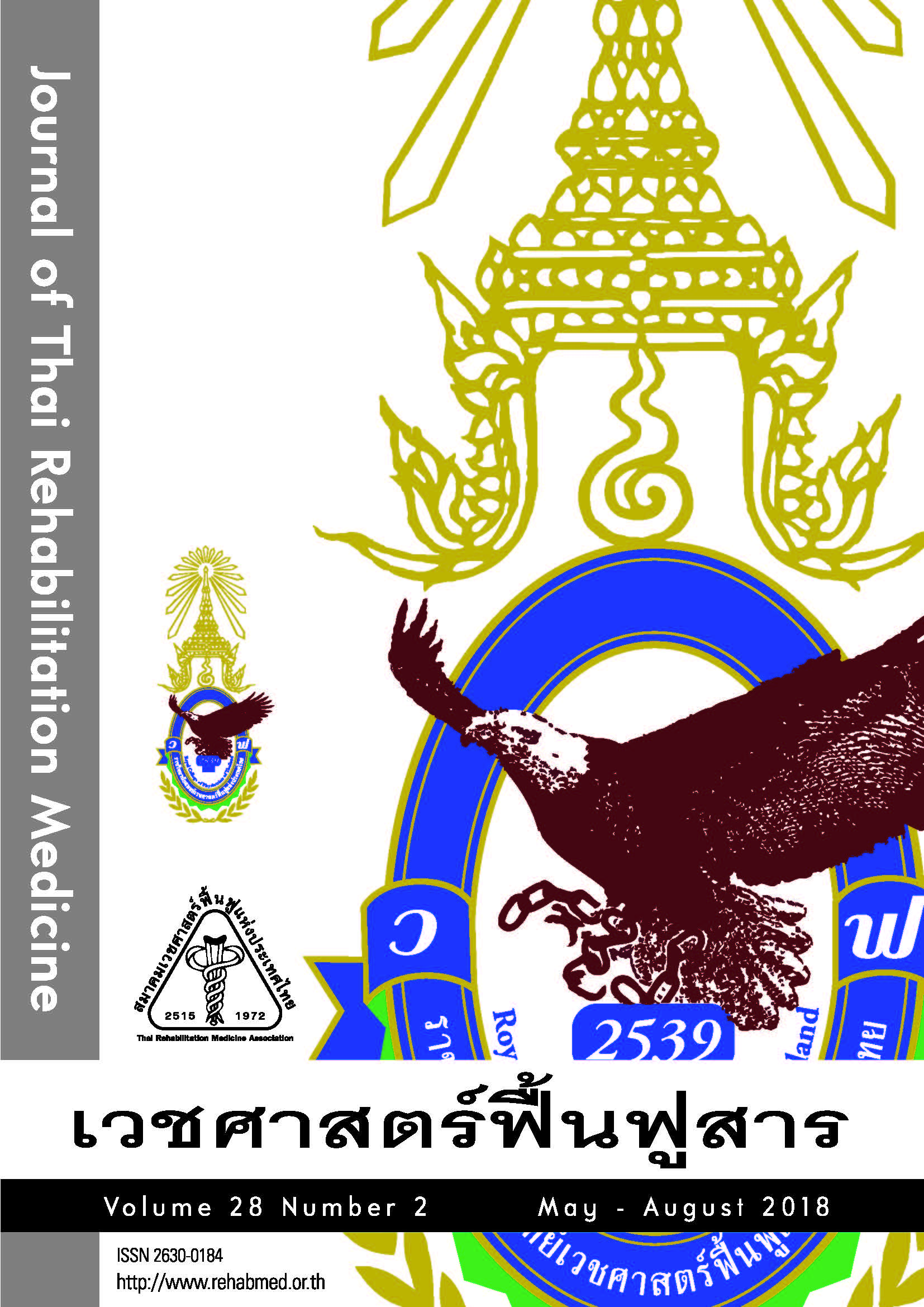ผลของโปรแกรมการฟื้นฟูหัวใจแบบกลุ่มต่อระดับคุณภาพชีวิตในผู้ป่วยภายหลังการผ่าตัดหัวใจแบบเปิด
ผลของโปรแกรมการฟื้นฟูหัวใจแบบกลุ่มต่อระดับคุณภาพชีวิตในผู้ป่วยภายหลังการผ่าตัดหัวใจแบบเปิด
Keywords:
cardiac rehabilitation, Quality of life, SF-36Abstract
Objectives: To evaluate the effects of group therapy in cardiac rehabilitation program on quality of life (QOL) and functional status in open heart surgery patients.
Study design: Prospective study.
Setting: Cardiac Rehabilitation unit, Rehabilitation Medicine Department, Faculty of Medicine Ramathibodi Hospital, Mahidol University.
Subjects: Low and moderate risk group of patients who plan to received open heart surgery for coronary artery bypass graft (CABG) and/or heart valve surgery underwent cardiac rehabilitation program from May, 2014 to February, 2016
Methods: The patients received a group-cardiac rehabilitation program from preoperative time to postoperative time. Then, their QOL was assessed before surgery and at 1, 3 and 6 months after surgery with the short form 36 (SF-36) questionnaire.
Results: Forty-eight patients with mean age (standard deviation) of 63.17 (10.06) years were recruited. For QOL mean (standard deviation) of SF-36 total score before surgery, and at 1, 3, and 6 months after surgery were 54.57 (17.06), 53.69 (15.37), 63.78 (16.40) and 69.50 (17.05), respectively. The SF-36 total score was significantly increased at 3 months after surgery with the mean difference between before surgery and at 3 months after surgery of 9.20 (95% CI = 4.32, 14.08).
Conclusion: Low to moderate risk group of open heart surgery patients who received group-cardiac rehabilitation program had better quality of life at 3 months after surgery..
References
2. Department of nursing, King Chulalongkorn memorial hospital. Cardiac surgery nursing in adult patient: CARDIOVASCULAR_NURSING/Training_Program.pdf. Retrieved January 25, 2017, from http://www.chulalongkornhospital.go.th/nurse/images/
3. Phillips N, Gotter A. Open heart surgery: healthline.com. Retrieved January 25, 2017, from http://www.healthline.com/health/open-heart-surgery#Overview1
4. The Society of Thoracic Surgeons of Thailand. Cardiac Surgery Statistic in Thailand from 2001 to present: thaists.org. Retrieved January 25, 2017, from http://thaists.org/news_detail.php?news_id
5. Achttien RJ, Staal JB, van der Voort S, Kemps HM, Koers H, Jongert MW, et al. Exercise-based cardiac rehabilitation in patients with coronary heart disease: a practice guideline. Neth Heart J. 2013;21429-38
6. Mampuya WM. Cardiac rehabilitation past, present and future: an overview. Cardiovasc Diagn Ther. 2012;2:38-49.
7. Jelinek HF, Huang ZQ, Khandoker AH, Chang D, Kiat H. Cardiac rehabilitation outcomes following a 6-week programe of PCI and CABG patient. Front Physiol. 2013;4:1-7
8. Ghashghaei FE, Sadeghi M, Marandi SM, Ghashghaei SE. Exercise-based cardiac rehabilitation improves hemodynamic responses after coronary artery bypass graft surgery. ARYA Atheroscler. 2012;7:151-6.
9. Kobkitsumongkol K, Uaaree P, Voraakom A, Sanjaroensuttikun N. Clinical outcome in cardiac rehabilitation patients of Ramathibodi university hospital. Journal of Boromarajonani College of Nursing, Bangkok. 2011; 27:1-13
10. Saeidi M, Mostafavi S, Heidari H, Masoudi S. Effects of a comprehensive cardiac rehabilitation program on quality of life in patients with coronary artery disease. ARYA Atheroscler. 2013;9:179-85.
11. Horner-Johnson W, Krahn GL, Suzuki R, Peterson JJ, Roid G, Hall T. Differential Performance of SF-36 Items in Healthy Adults With and Without Functional Limitations. Arch Phys Med Rehabil. 2010; 91: 570-5.
12. Hays RD, Hahn H, MarShall G. Use of the SF-36 and Other Health-Related Quality of Life Measures to Assess Persons with Disabilities. Arch Phys Med Rehabil. 2002;83:S4-S9.
13. Krittayaphong R, Bhuripanyo K, Raungratanaampom O, Chotinaiwatarakul C, Chaowalit N, Punlee K, et al. Reliability of Thai Version of SF-36 Questionnaire for the Evaluation of Quality of Life in Cardiac Patients. J Med Assoc Thai. 2000;83:130-6.
14. Bass K, Herbert WG, Bos R, Sebolt D, Redican K. Quality of life three months after coronary artery bypass surgery: effects of presurgical physical fitness. Master’s thesis, Faculty of Virginia Polytechnic Institute and State University. 1998 Apr 21.
15. Ngamchaweng T, Chaiwanichsiri D. Quality of Life after Cardiac Rehabilitation of Post CABG Patients in King Chulalongkorn Memorial Hospital. J Thai Rehabil Med. 2001;10:107-16.
16. Kurfirst V, Mokráček A, Krupauerová M, Canádyová J, Bulava A, Pešl L,et al. Health-related quality of life after cardiac surgery--the effects of age, preoperative conditions and postoperative complications. J Cardiothorac Surg. 2014; 9:46.






